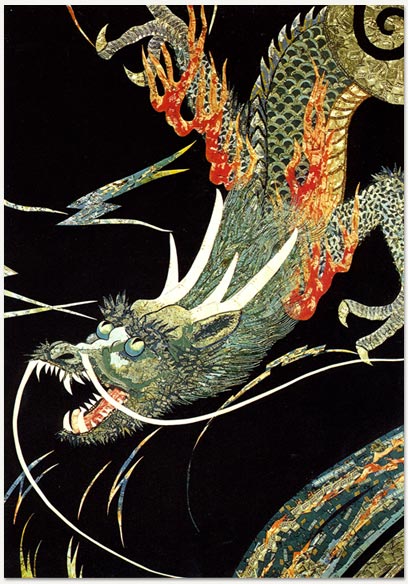Quote: “Several years ago, at a sumptuous Chinese dinner in Geneva, my hosts asked whether I would do them a favor, or, rather, a favor for their cook, who had prepared the banquet. I intended driving through the Alps later that night, to arrive at dawn on the French Riviera for celebrations honoring the ninetieth birthday of Pablo Picasso; who would surely remain behind his locked gate working, as on any other day. He once had sighed, “If people could only give me their wasted hours! Instead, they bring me things.” So, when my friends explained that their cook wanted me to take a gift to Picasso “from an admirer who never met him,” I tactfully declined. My friends actfully persisted. ‘This one is different! It’s a good-luck picture, the Chinese god of Happiness and Long Life—made from tiny fragments of postage stamps.” Next morning I arrived on the Riviera as the gift-bearing envoy of Hsueh Shao-Tang . . . master artist and master chef.” –David Douglas Duncan.
As a young man Hsueh Shao-Tang fantasized about being an artist, but life intervened, as it has a nasty habit of doing. He was living in Peking when Mao Tse-Tung’s Communists swept through northern China, so the first order of business had to be entirely more practical. Hsueh’s family had an ancestral silk business but the war-time conditions of Peking had made it impossible to continue and Hsueh was ultimately reduced to roaming the countryside to hunt out food for his parents and sister. The hunt brought him to Shanghai where he was snatched off the street by “recruiters” for Chiang Kai-shek’s Nationalist army. He spent the next six years guarding against communist invasion in Taiwan and never saw his family again.
After being discharged he was desperate for some reliable means to support himself (and his new family- a wife and two children) so he enrolled in a school for classical Chinese cuisine. He did so well as a chef that after graduating cum laude he was sent to Turkey as the official chef for the Chinese ambassador there. It was during this three year period that he began to once again devote private hours to his art. Said art consisted of cutting postage stamps into fine little shards and gluing them onto silk to form traditional compositions. After the ambassador’s death he was invited to bring his family to Geneva, where he would cook banquets on holidays and could devote the rest of his time to his art.
What follows are 10 pieces created by Hsueh Shao-Tang during his time in Geneva.






Quote: “How many stamps have I cut to pieces making pictures? I’ve made about five hundred pictures—given them to friends and sold some, too. Big ones take up to a month. Let’s say they average fifteen hundred stamps apiece. But, of course, some need many more—up to ten thousand. For one picture! Anyway, I’ve chopped up nearly a million stamps. Whole stamps—forget the fragments! And, some days, it seems like that many cabbages, too, for those spring rolls!
I need maybe a thousand different Chinese stamps. Not Red Chinese . . . Taiwan! Friends buy them and send them from Taipeh. It’s terrible how the cost has increased in ten years! Of course, all are old stamps. Nobody could buy new ones. I’ve never used any Communist stamps although their colors are very strong. But not as good as Taiwanese. They’re the best. I’ve used about five hundred different Western stamps, too, but they are very expensive and the colors aren’t as beautiful. Naturally, my glue is special—my secret. It will never stain stamps or the silk on which I paste the fragments—it holds stamps and silk together perfectly . . . maybe forever!” -Hsueh Shao-Tang.





Gorgeous. The little snatches of text and image you find in say a bird feather, the tiger’s skin, or some leaves is fantastic. I’d love to see one up close and personal.
All of the quotes and images are from the book Magic Worlds of Fantasy by David Douglas Duncan, published 1978.
Unfortunately I was unable to find any further information on Hsueh Shao-Tang beyond that shared by Mr. Duncan, and while there are plenty of copies of Magic Worlds of Fantasy to be found for purchase on the web I was only able to find two small images of Hsueh Shao-Tang’s work. That strikes me as a real shame, as I’d love to see more of his work, but more so, after such a touching biographical sketch, I’d love to know how the artist and his art fared once he was able to devote himself to it.
Hope you enjoyed.


